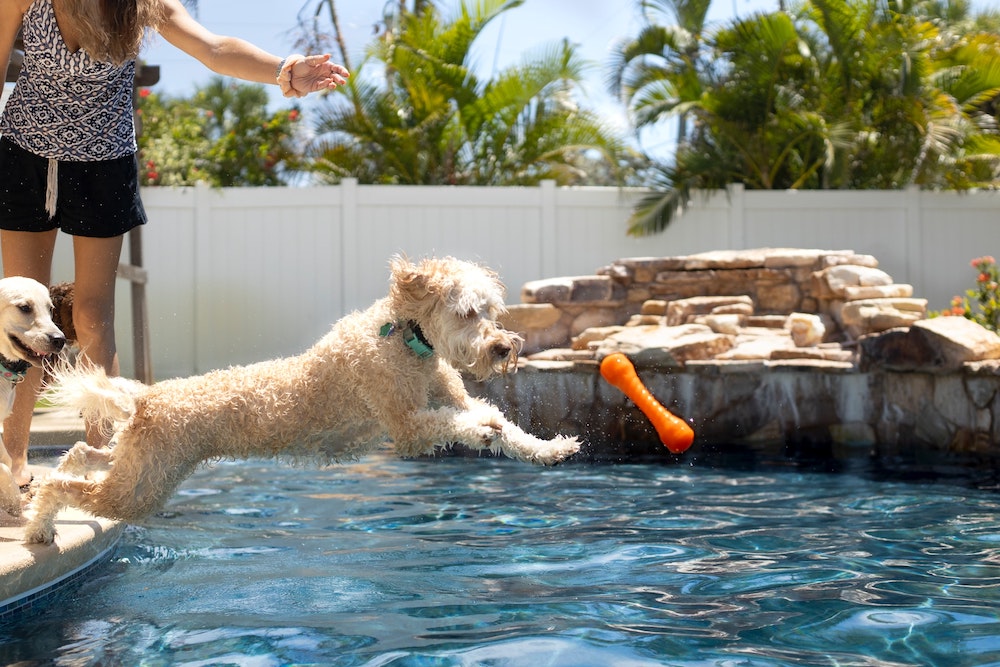Is it OK to let dogs swim in your pool?
- October 14, 2021
- Blog,

Just five minutes on YouTube and you’d think that man’s best friend and swimming pools are a match made in doggie heaven. If you’ve got a pup and a pool, you know the allure.
We get asked a lot whether it’s safe for our dogs to swim in our backyard pools with us. The short answer is yes, but it’s not that simple. Know that if you do choose to let your dog swim in your pool, you will need to increase how much you treat your water chemistry and maintain your equipment. Here’s what you need to consider before letting your four-legged friend jump in with you.
Is Your Dog A Strong Swimmer?
As is with humans (or “hoomans” in dog-speak), swimming is great exercise for dogs that combines the benefits of aerobic activity with low impact. So, yes, in this way it’s perfectly safe for your dog to swim in your pool. But every dog differs in how much they enjoy swimming.
Some breeds — Labradors, Chesapeake Bay Retrievers, Portuguese Water Dogs, and Setters, to name a few — are excellent swimmers, and many can’t wait to jump right in. But other breeds — Pugs, Bulldogs, Terriers, Corgis, and many others — are not very strong swimmers because of their body shape or genetic traits that make it difficult for them to breathe. Always be sure to consult your veterinarian should you have any questions about your dog’s swimming ability.
Tips for training your dog to swim
- ALWAYS limit your pup’s exercise in the pool so they don’t exhaust themselves — no more than 10 minutes at a time.
- ALWAYS supervise your dog’s swimming, and be within arm’s reach in case of emergencies.
- NEVER leave your dog unattended by the pool. Some dogs are not good swimmers and leaving them alone could be a tragic accident waiting to happen.
- NEVER toss your dog into a pool.
- NEVER force your dog to swim. Let them come into the pool on their own if they’re interested.
- Swimming may take some time for your dog to adjust. Use a small, floating toy if you want to start gauging their interest.
- The American Kennel Club recommends using a life vest made specifically for dogs with all pool activities, or a dog life jacket (there is a difference), to increase buoyancy and visibility.
Celebrity dog trainer Cesar Milan suggests teaching your dog to get out of the pool before getting in it, since most dogs won’t be able to use a pool ladder to get out. If you watch the video, you can see how overwhelming it can be for your dog to learn this skill at first. This might mean you’ll need to install dog-friendly steps in your pool if you wish to do so. Beach or ramp entries are even easier for them to use.
Pool chemistry and your dog’s health
While pool water is relatively harmless for dogs to swim in, chlorine is still extremely toxic to dogs when ingested. And, as every dog owner can attest, dogs will drink whatever water you put in front of them. That habit is especially hazardous with a big pool of chlorinated water, which can cause gastrointestinal upset, nausea, vomiting, esophageal damage, or even death in rare circumstances.
Always leave fresh water out for your dog to drink when they get thirsty. AKC also recommends placing your chlorine supplies, like tablets or granule buckets, in an area where your pets can’t reach them.
While a pool’s chlorine levels are generally safe for dogs, some can experience the same irritations that chlorine exposure can impart to humans, like irritation to the eyes, skin, and ears. Chlorine can also stay on a dog’s coat. Because of these reasons, the American Kennel Club recommends washing your dog off with fresh water before and after they start swimming in your pool, and also cleaning inside their ears to prevent infections.
How your dog affects your swimming pool’s chemistry
Now for the major equalizer: dogs are dirty. That’s just the way they are. Some estimates say that one dog in a pool equals three humans, carrying many more contaminants on their coats than humans do. Dirt, debris, and the occasional bits of fecal matter on their hind ends can wreak havoc on your pool’s chemistry.
And that’s just the beginning. Their hair can clog up your filtration system, they’re more likely to pee and poop in the pool than an adult human, and their nails can scratch tiles and vinyl liners. In worst-case scenarios, parasites can contaminate your water if your dog isn’t up-to-date with their shots or medications. All this adds up to increased maintenance across the board, so be prepared for more work to keep your pool healthy and clean if you’re sharing it with your dog.
In general, the risk of your dog contaminating your pool is certainly something to consider. The next time Spot wants to dip his paws in, make sure you’re considering all the options before jumping in for a fun and safe swim!


